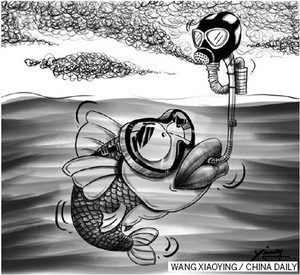Water, environment and development
Updated: 2013-06-05 08:02
By Peter Brabeck-Letmathe and Asit K. Biswas (China Daily)
|
|||||||||
As we mark the World Environment Day (June 5), it would be pertinent to reflect on why a serious issue like water and its close interrelationship with the environment has for all practical purposes disappeared from the global political agenda.
The increasing demand for water, coupled with poor management practices over decades, has already caused a lot of damage to the environment. Take the Aral Sea for example. During the first half of the 20th century, it was the world's fourth-largest inland water body with a surface area of about 68,000 square kilometers, equivalent to more than half the area of England.

In the early 1960s, the Soviet Union government decided to divert the waters of the two major rivers, Amu Darya and Syr Darya, which fed the Aral Sea to irrigate the arid areas of Kazakhstan, Uzbekistan and Turkmenistan (which then were part of the Soviet Union). The Karakum Canal, whose construction was completed in 1967, diverted the waters of the Amu Darya to irrigate the perennially dry areas of nearly 3 million hectares primarily to grow cotton. Although irrigation was successful, it sounded the death knell for the Aral Sea. The Amu Darya, which has been completely cut off from the Aral Sea, now ends in a dam some 110 km away.
The Aral Sea started to shrink as soon as the water diversion started. Its surface area has reduced to one-fourth of its original size and its water volume has diminished by 90 percent. The Aral Sea used to produce more than 40,000 tons of fish a year, but by the early 1980s the fishing industry had collapsed, dealing a deadly blow to the communities that depended on it. By the late 1980s, because of the serious reduction in river flows, the sea split into two distinct water bodies, North and South Aral. The South Aral Sea split further into eastern and western sections. Moreover, with no fresh water coming in, salinity started to increase and all the 24 species of native fish species of the sea disappeared.
As the Aral Sea shrank, it left behind a highly saline bed that was contaminated with pesticide and fertilizer runoffs spanning decades, leading to a serious public health hazard. As a result, infant mortality became one of the highest in the Soviet Union and the incidence of cancer and respiratory diseases increased significantly.
The rising demand for water, continuing poor management practices and erratic rainfall patterns are causing water crises across the world. For example, the first official national river census of China said the country had 22,909 rivers, each with a catchment area of at least 100 sq km, at the end of 2011. This is less than half of the more than 50,000 rivers estimated by the government in the 1990s. The official explanation for this shortfall is mainly the "inaccurate estimate of the past, as well as climate change, (and) water and soil loss". This could explain why some of the rivers have disappeared, but the primary causes are likely to be declining groundwater and river flow levels, widespread deforestation and increasing withdrawal of water from water bodies.

 Michelle lays roses at site along Berlin Wall
Michelle lays roses at site along Berlin Wall
 Historic space lecture in Tiangong-1 commences
Historic space lecture in Tiangong-1 commences
 'Sopranos' Star James Gandolfini dead at 51
'Sopranos' Star James Gandolfini dead at 51
 UN: Number of refugees hits 18-year high
UN: Number of refugees hits 18-year high
 Slide: Jet exercises from aircraft carrier
Slide: Jet exercises from aircraft carrier
 Talks establish fishery hotline
Talks establish fishery hotline
 Foreign buyers eye Chinese drones
Foreign buyers eye Chinese drones
 UN chief hails China's peacekeepers
UN chief hails China's peacekeepers
Most Viewed
Editor's Picks

|

|

|

|

|

|
Today's Top News
Shenzhou X astronaut gives lecture today
US told to reassess duties on Chinese paper
Chinese seek greater share of satellite market
Russia rejects Obama's nuke cut proposal
US immigration bill sees Senate breakthrough
Brazilian cities revoke fare hikes
Moody's warns on China's local govt debt
Air quality in major cities drops in May
US Weekly

|

|








